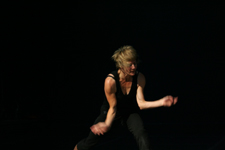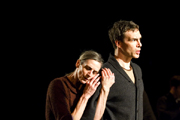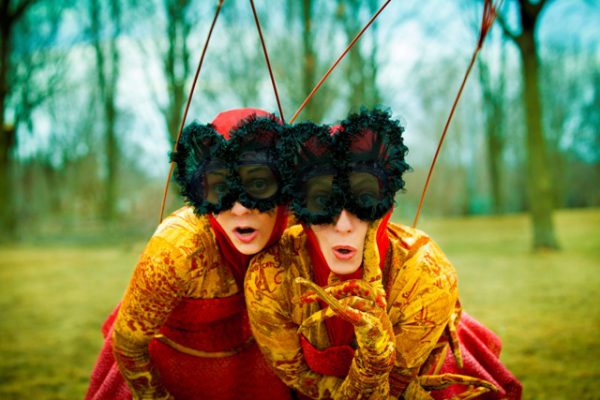Founded in 2004 to break down the barriers between the worlds of ballet and modern dance, ProArteDanza presented their latest program, a collection of three works, at the Fleck Dance Theatre at Harbourfront Centre in Toronto. Drawing on talent from the ballet and contemporary fields, Artistic Director Roberto Campanella and Artistic Associate Robert Glumbek fulfilled their stated goal with pieces that bridged the two solitudes in terms of choreography, music and choice of interpreters.
First on the program was the North American premiere of Glumbek’s 2012 work Shifting Silence. Created for seven dancers to the music of Johann Sebastian Bach and German electronica composer Senking, Shifting Silence was made in Germany for Kevin O’Day’s Ballett Nationaltheater Mannheim. The work revolves around the fate of a lone man, performed by the tall, lean Tyler Gledhill. Dressed in a red shirt and trousers, Gledhill stands in a rectangular box of light cut off from the rest of the cast. In a meditation on solitude, Gledhill performs a beautiful solo (to a Bach violin concerto) that keeps him confined to his allotted space. Gledhill’s movements ache to extend beyond his imaginary walls but then appear to self-implode into sharp staccato twitches and flailing. The other dancers gradually emerge from the wings, standing on the periphery, watching him through the gloom.
Eventually the light box lifts and the music abruptly changes from classical to ambient. It ends Gledhill’s self-focused reverie and he begins to interact with his fellow performers; a series of duets and trios follow that are uniformly sombre and unfulfilled. The dancers do not make eye contact and rarely connect in any meaningful way. Delphine Leroux, also in red, stands out from the other dancers who are dressed in grey and thus seems destined for Gledhill. The two perform a pas de deux, but their interaction is cold and goes nowhere. Only when Gledhill dances with the slight, fair and intrinsically musical Ryan Lee are we treated to any tangible expression of connection or poignancy. Gledhill tutors Lee throughout his opening Bach solo, taking his weight and guiding his arms. The two move together inside Gledhill’s lit box and the choreography seemed complete. Despite some gorgeous, kinetic movement from Lee, Mami Hata and Anisa Tejpar, the combination of the monochromatic choreography and costumes and a flat lighting design make this the least interesting work of the night.
Second on the bill was the world premiere of Beethoven’s 9th Symphony – 3rd Movement, choreographed jointly by Campanella and Glumbek. Cognizant that Beethoven’s Ninth Symphony is a titan of the repertoire, the two are gamely up for the challenge, producing a piece that succeeds in keeping the music in the background.
To its opening strains, dancers appear from the wings making their way across the stage in pairs, creatively using chairs to aid their crossing. Lee and Tejpar come first, using their chair as a sled and then as a table, playfully getting tangled up in the legs of the chair, and then untangling themselves. The piece unfolds as a game of love and chairs, with dancers moving purposefully about the stage in duets, trios and groups that naturally develop and then dissolve. Once again Lee, Hata and Tejpar’s presence and clarity of movement crystallize in vignettes that at times overshadow the other dancers. Lee’s fluidity and deftness, Tejpar’s flexible spine and Hata’s strength bring Campanella and Glumbek’s choreography to fruition.
At one point the ensemble creates a tableau of bodies and chairs that winds across the stage. The effect is reminiscent of a war memorial, with bodies staggered across the space holding poses that convey a forward momentum yet a heavy burden. Oz Weaver’s nuanced lighting design captures the moment perfectly.
Overall Beethoven’s 9th Symphony – 3rd Movement had a much more coherent design and movement vocabulary than the opening work, with dancers appearing to take greater ownership of and pleasure in the movement. The simple costumes of blue T-shirts and blue trousers for the men and blue sheer blouses with black trunks for the women (coordinated by Tejpar) contributed to a seamless look – though the black socks were very distracting.
The final piece on the program, National Ballet of Canada principal dancer Guillaume Côté’s Fractals: a pattern of chaos was nothing short of brilliant. Côté, a supremely gifted dancer, choreographer and composer, created Fractals for ProArteDanza in 2011. In light of the critical praise and Dora Award nominations it received, ProArteDanza decided to remount the piece for its 2013 season.
For this work, Campanella and Glumbek augmented their ensemble with the addition of independent dancer Valerie Calam and she, along with Hata, Lee and Justin de Luna, gave Côté’s choreography incredible zing. At one point de Luna performed an acrobatic solo that featured huge arcs of his body in the air and on the floor.
The lighting design – originally created by Arun Srinivasan and adapted by Weaver – allowed the dancers to enter almost unseen through the openings in the rear black backdrop, advancing forward to swell the ranks and join in sections that primarily used the front third of the stage. The combination of staging and lighting contributed to the unrelenting tension of the piece.
Côté’s lightning-quick movements – powerful fluttering, flicking and slashing of the arms, hands and fingers while the head and torso remain still, highlighted in downward pools of light – require a concerted attack. Here – where speed, sharpness and clarity count most – the differences between the classically trained and modern-trained dancers were most evident. A pas de deux for Leroux and Gledhill in the middle of the work, intended perhaps as a hiatus from all the hyperactivity, was limp and imprecise.
In Fractals, the performers have to keep up with Côté’s choice of score, a frenetic, all-over-the-map composition by Canadian electronica composer Venetian Snares. The dancers’ vibrating limbs frequently accompanied high-octane drum solos. The effect was both startling and intimidating as the pace of the choreography, the stark lighting and the music simply did not let up.
Taken as a whole, ProArte’s Season 2013 was successful – some great dancing (most especially Ryan Lee), some clever movement invention, some interesting ideas – but it could have had a more coherent voice. Côté’s Fractals had a distinctive look and feel that overshadowed the pieces that preceded it. There is definitely room on the Canadian dance scene for ProArteDanza’s particular artistic vision, one that brings together high-calibre dancers and choreographers of note. But the venture would benefit from consistent production values.




